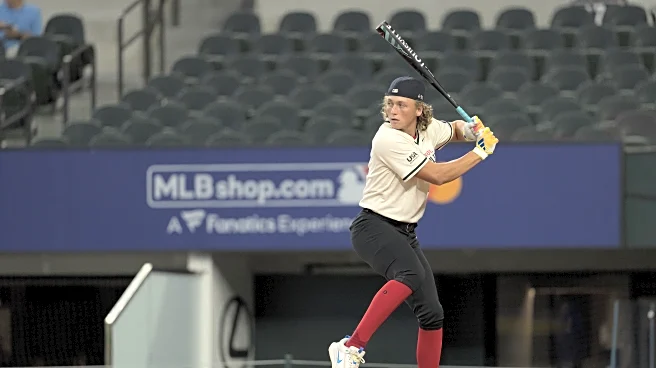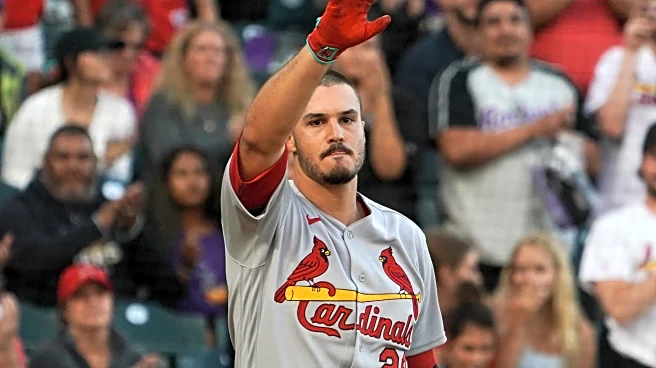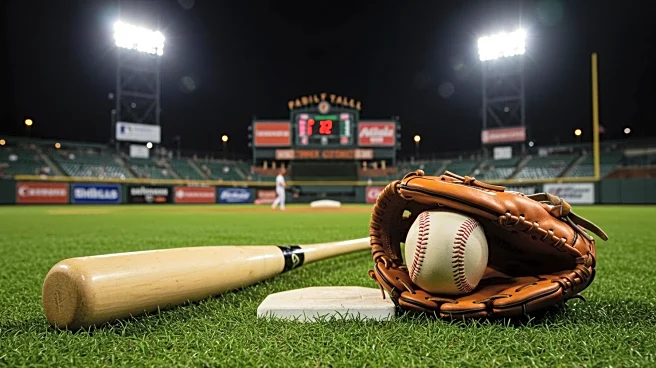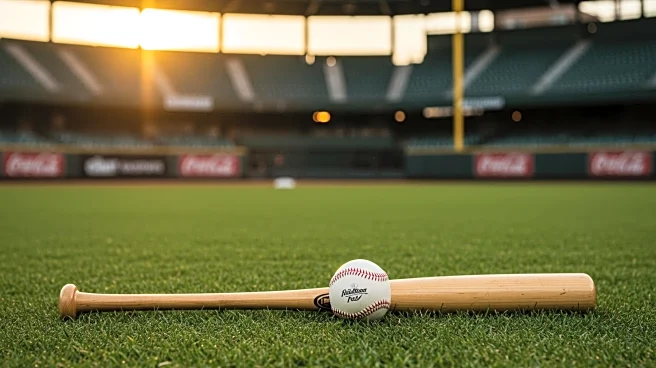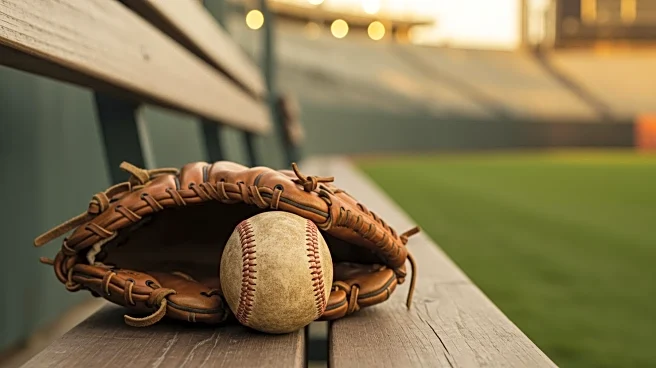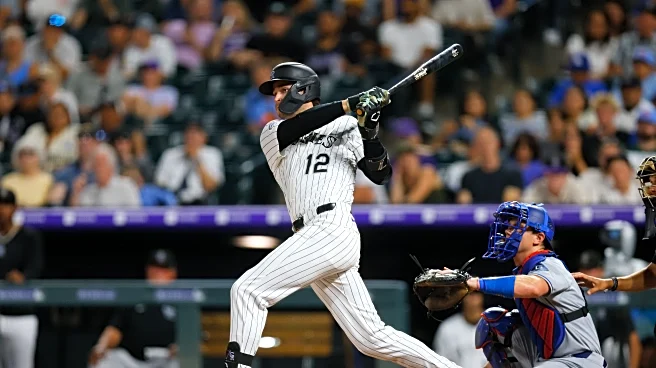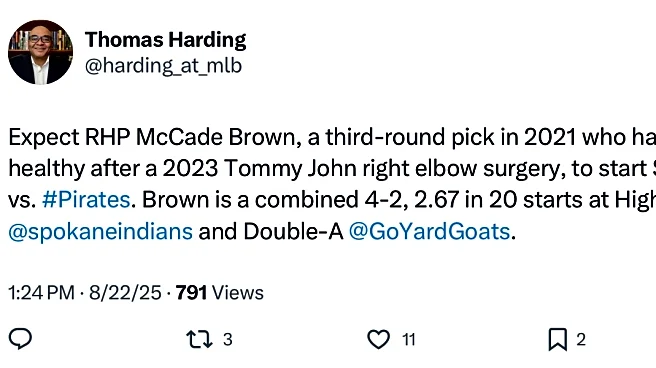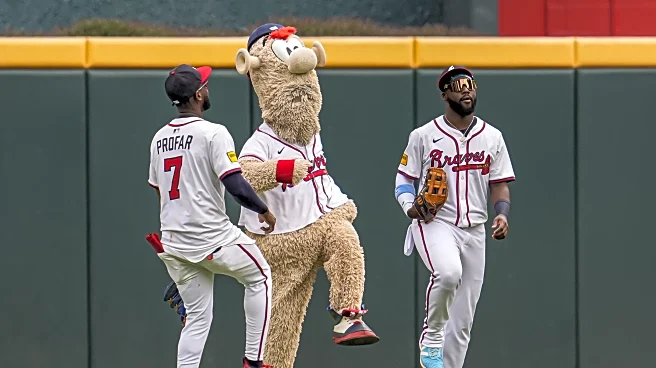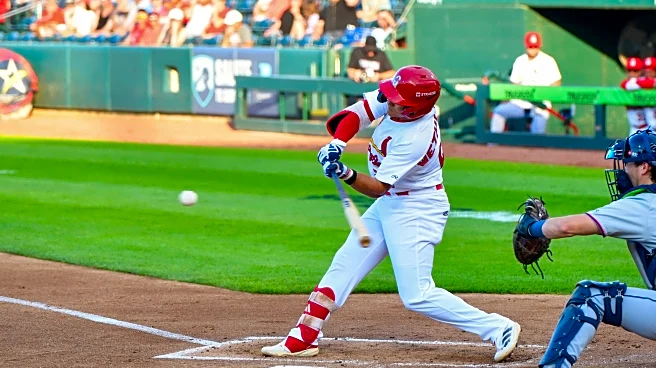
In the process of Purple Row Prospects (PuRPs) voting, there were two names that stood above the rest — Colorado’s most recent first rounders: outfielder/first baseman Charlie Condon from last year and shortstop Ethan Holliday from this year. Ultimately, Holliday took 16 of the 23 first place votes to earn the number one PuRP designation. So who are these top two prospects? Read on!
2. Charlie Condon (657 points, 23 ballots) — Preseason Ranking: 2 — High Ballot 1 (5), Mode Ballot 2
How did he enter the organization?
2024 First Round, University of Georgia
Why did he make the PuRPs list?
Condon’s 2024
professional debut was a bit of a dud, but his first full season as a professional has seen the 22-year-old righty slugger hit his way to Double-A. Condon received a MLB record-tying $9.25 million bonus as the third-overall pick in the 2024 draft (about $180k over slot) because of his huge offensive ceiling. He can translate his immense power into games, he hits for average, and has rare defensive ability for his size.
Condon was a one-man wrecking crew in 2024 for Georgia, as the 6’6”, 216-pound hitter smashed 37 homers — a record in the NCAA’s “BBCOR” bats era — and won the prestigious Golden Spikes award as the top amateur baseball player in the country. Given that success, it’s hard to believe that Condon (who played first, third, and all three outfield positions for Georgia) not only went undrafted as a high schooler but also was a walk-on who redshirted in 2022.
In 2023, Condon stepped into the Dawgs’ lineup and was an immediate success, swatting 25 homers in 56 games en route to a video game line of .386/.484/.800 in 254 plate appearances. That certainly got him on draft radars, and the aforementioned 2024 power explosion rocketed him up to, for many, the very top of the draft. In 304 plate appearances over 60 games for Georgia in 2024, Condon not only hit 37 homers, he also added 20 doubles and a triple while walking 16 more times than he struck out. In all, Condon hit a massive .433/.556/1.009 in 2024!
The Rockies assigned Condon straight to High-A Spokane, as befits a player many tabbed to move very quickly through the system. Unfortunately, Condon was downright bad for Spokane, hitting an anemic .180/.248/.270 (48 wRC+) with 34 strikeouts compared with four walks in 109 plate appearances while dealing with a bruised thumb. Condon did have six extra-base hits, including a homer, and four stolen bases (which is more than his entire collegiate total in two years at Georgia). That performance certainly soured many on Condon, but he still entered 2025 on many top 100 lists.
The season didn’t get off to a good start for Condon, who suffered a non-displaced left wrist fracture in his very first minor league Spring Training game. The injury kept Condon out until mid-May (after a nine-game rehab stint with the complex league team) when the Rockies sent Condon back to Spokane. Condon was much more successful in his return engagement, hitting .312/.431/.420 in 167 plate appearances across 35 games with three homers and six doubles (133 wRC+). The Rockies promoted Condon to Double-A Hartford on July 1st, where he is 1.5 years younger than league average — and not long after, Condon was selected to the prestigious MLB Futures Game (he started at first base and went 0-for-3).
In 162 plate appearances with Hartford (through Saturday), Condon has a very good .267/.377/.526 batting line with eight homers among his 17 extra-base hits, which is an impressive 159 wRC+. There are still warts on the profile — Condon has struck out in 28% of his plate appearances in Double-A (walking in 12%) and he has seemingly slid down the defensive spectrum from a third baseman/outfielder to primarily a first baseman (one error in 58 games there) who occasionally plays left field and third base. Fans expecting the monstrous power Condon showed at Georgia are also no doubt expecting more too, but at the end of the day a 159 wRC+ in Condon’s initial exposure to Double-A is pretty encouraging.
Here’s some looks at Condon in game action with Spokane late last season:
Here are some of Condon’s 2025 highlights to date.
What do the scouts say?
Multiple outlets ranked Condon atop their 2024 draft rankings and most of them still have Condon in their top 100.
Keith Law of the Athletic had Condon as the number one player in the draft, then ranked Condon 26th overall in his mid-season top 50 (number one in the system):
Condon broke his wrist on a diving play in spring training and missed the first eight weeks of the minor league season before returning to High A, where he improved on last year’s disastrous debut by hitting .312/.431/.420 in 35 games before Colorado bumped him up to Double A. He’s continued to hit at that higher level, still not showing a ton of power – unsurprising off a wrist injury this year and a thumb one last year – but, more concerningly, still showing a lot of trouble picking up sliders. He’s seen 48 so far in Double A (per data from Synergy Sports), swung at half of those, and whiffed on half of those swings. When he hits them, it’s for damage, and that might be what saves him given this deficiency at the plate. Assuming that 30-homer power he showed before the injuries is still there, he may be more of a low-OBP, high-power guy, at least until and unless he shows he can pick up the slider much better than he has to date.
MLB Pipeline (who had him second among draft prospects) ranks Condon 60th overall as a 55 FV player with a plus power grade and a 55 hit tool:
At Georgia, the 6-foot-6 Condon used an upright stance and simple mechanics to deliver incredible raw power in games for the Bulldogs, showing the ability to hit the ball out to all fields with bat speed, strength and leverage. The raw power was evident after he signed with the Rockies, but he lost the approach that made him such a tough out in college, with a 34/4 K/BB ratio over 100 at-bats in the High-A Northwest League. The hand clearly was an issue, and then he tried to do too much. At his best, he controls the zone well and makes consistent hard contact.
Condon is a solid athlete given his size, and while he has below-average speed, he’s better underway. He played all three outfield spots and third base at Georgia last year and saw most of his time with Spokane in left field, with some time at the hot corner mixed in. He likely profiles best in an outfield corner with a strong arm, and the Rockies were very impressed with how he prepared and handled his struggles during his pro debut.
Here’s Kiley McDaniel of ESPN.com’s pre-season profile of Condon as a 55 FV player, 40th overall:
Type: Potential Kris Bryant-type upside, but a poor pro debut has his momentum going the wrong way
Condon was lightly recruited out of high school and wasn’t a pro prospect until his sophomore year at Georgia. He put up huge numbers largely in a corner position, which for Condon came split between first base, third base and the outfield. By his draft year, Condon improved at third and was giving Kris Bryant vibes as a third base/outfielder tweener with a lean frame and 30-homer upside along with good-enough on-base skills. He was narrowly my top-ranked prospect in the 2024 draft — a virtual toss-up with Travis Bazzana, just ahead of JJ Wetherholt, Jac Caglianone, Chase Burns and Hagen Smith.
As you could guess from this ranking, Condon had a very poor pro debut, which raised all the questions I raised at draft time. A slow start in pro ball was somewhat predictable as he has had trouble keeping weight on through an entire season, which would affect his power and stamina late in the summer, and he was also battling a hand injury — but his performance was worse than expected even considering those factors. Condon’s bat control played a tick or two lower than expected, as did his in-game power indicators. It was a relatively small sample (25 games), it was High-A (Wetherholt only played in Low-A), and some other top 2024 picks haven’t even had debuts yet, so it’s unfair to really spike Condon’s prospect status. That said, flags have been raised and we’ll need to watch his start to 2025 closely.
Baseball Prospectus ranked Condon 42nd overall preseason and second in the system with a 60 OFP grade. Here’s Jeffrey Paternostro:
Condon was poised to be a first-round pick in the 2024 draft as an eligible sophomore. He promptly went out and hit .433/.556/1.009 (yeah that last one is slugging, not OPS) and moved himself quickly into the first-overall pick conversation. He improved against fastball velocity and did as much damage on contact as any college player in the class, including Jac Caglianone. While I had some misgivings about the pitch recognition and overall contact ability, especially against spin lower in the zone, it was tough to doubt his ferocious bat speed and power projection. Condon had split time between third base and the outfield, and the grass seemed a better fit, but there was little concern based on the draft year performance that the bat would play there if he couldn’t hack it at third in the pros.
Condon then went to the Northwest League for 100 PA or so after the draft and his OPS went down by two-thirds with downright concerning peripherals and underlying metrics. He started chasing and whiffing a lot more against pro stuff and in a way that raised our eyebrows more than Travis Bazzana’s or J.J. Wetherholt’s slightly down debuts. My general philosophy in situations like this have been to give prospects some level of a pass. The transition to pro ball from college is real and complex and comes when they’ve already been playing games since February. Still, I can’t shake my worries from my early season video work on Condon. Our final board blurb called him “an enticing blend of safety and dynamic upside.” The dynamic upside is still obvious, perhaps the safety a little less so. Still, we will give him some level of a pass for now.
The pro debut exacerbated some concerns I had about Condon’s hit tool going back to the beginning of his breakout college campaign, but obviously if it’s just a post-draft fatigue blip, this could easily be an OFP 70 by May 2025.
Eric Longenhagen of Fangraphs is less enthusiastic about Condon, grading him as a 45+ FV player outside the top 100, second in the system (after ranking him fourth among draft prospects) with a 70 raw power and 60 future game power grade:
Condon went third overall, signed for $9.25 million, and then had a no good very bad pro debut at Spokane during which he hit .180 and struck out 31.2% of the time. During instructs, Condon played defense but didn’t get at-bats, as if he was being given time away from the plate to reset. Perhaps because I was already relatively skeptical of Condon’s contact ability before the draft, I am reading his post-draft performance as signal, rather than a small sample aberration or the result of exhaustion.
Condon’s swing is relatively grooved and stiff. He swings really hard and has an incredible ability to turn on pitches on the inner third, especially for a 6-foot-6 guy, but Condon doesn’t have great feel for manipulating the barrel. His swing generates enormous power on pitches down and in, but it lacks precision and variability in other parts of the zone, and he has hit tool risk despite his college performance. He was late on basically everything after the draft and wholly unable to pull the ball, which wasn’t the case when he was at Georgia, where Condon had a 90% contact rate against fastballs.
How much room Condon’s contact issues will have to breathe is going to depend on where he ends up playing defense. He played third base, first base, and all three outfield spots during his time in Athens and third base, and left field after the draft. Condon bends well for a player his size, but his range at the hot corner is well below average. He is a better thrower from the outfield than he is from third base, and I thought he looked surprisingly skillful in center field at Georgia, though he’s a 40-grade runner and likely not a long-term fit there. Here Condon is projected as a flawed but powerful multi-positional role player rather than an impact third baseman.
When’s he going to get to the Rockies and how good will he be once he’s there?
Multiple scouts have drawn comparisons between Condon and Kris Bryant. While, of course, Bryant’s tough few years with the Rockies have left a sour taste in the mind of fans, he deservedly won the Rookie of the Year and NL MVP awards in his first two years as a big leaguer and has been an All-Star four times. Condon has the kind of offensive potential and defensive utility that could make him a star in the league for several years, so he deservedly ranks in this range in the PuRPs poll — he was number two on my list as a 55 FV player.
Condon’s 2025 results haven’t been problem-free (strikeouts in particular) and I’m worried about his slide down the defensive spectrum, but it’s nice to see him doing some damage at Double-A. At this pace, the Rockies could certainly get Condon into the big league mix sometime next year if he forces the issue, though the role and impact is still up in the air.
1. Ethan Holliday (676 points, 23 ballots) — Preseason Ranking: N/A — High Ballot 1 (16), Mode Ballot 1
How did he enter the organization?
2025 First Round, Stillwater HS (OK)
Why did he make the PuRPs list?
Ethan Holliday is a name that has been well-known to Rockies fans for a long time, if only from the connection to his father, Rockies great Matt — not to mention his brother, 2022 number one overall pick Jackson. Those connections made it extremely likely the Rockies would call Ethan’s name on draft day if he were available at pick number four, but the 6’4”, 18-year-old lefty-hitting shortstop from Oklahoma is much more than just a famous name.
Holliday was the number four pick and received a (record for a high schooler) $9 million signing bonus because he has plus raw power that should translate into games and good pitch selection while playing a premium defensive position very well, though scouts are concerned his size might limit his range at shortstop in the long-term. They’re also concerned that Holliday wasn’t more of an elite performer in the summer showcase circuit where many highly regarded prospects travel to play each other.
In high school though, Holliday was monster, hitting .611/.743/1.295, a cartoonish 2.038 OPS, with 19 homers and 64 RBI. He was named the Gatorade Oklahoma Baseball Player of the Year and Baseball America’s High School Player of the Year. In both of those awards, he beat out number one overall pick and fellow Oklahoma prep shortstop Eli Willits.
As a pro, Holliday was recently assigned to Low-A Fresno, where he is 3.3 years younger than league average. In 32 plate appearances so far (through Saturday), Holliday is hitting .250/.344/.321 with two doubles and 12 strikeouts while making two errors in seven games at shortstop. Let’s not draw too many conclusions from a small sample, but Holliday doesn’t seem to be overmatched as a teenager in full-season ball.
Here’s some pre-draft video of Holliday at a Perfect Game showcase last year with looks at him taking grounders and batting practice:
What do the scouts say?
MLB Pipeline ranked Holliday as their top draft prospect and just listed him 17th overall as a 60 FV player with a 65 power grade and a 50 or better on the other tools:
Holliday may have the most usable left-handed power from his Draft class and he generates it with little effort. Still adding to his 6-foot-4 frame, he already has plenty of strength and an easy left-handed swing with plenty of bat speed and leverage. He tried to do too much when he got pitched around on the circuit last summer, leading to some swing-and-miss concerns, but he should develop into at least an average hitter with 35-homer pop and plenty of walks.
Holliday moves well for his size and has average speed, though he’ll probably lose a step as he continues to mature physically. He has nice actions and solid arm strength at shortstop, but he won’t cover enough ground to stay there on a long-term basis. He projects better as a slugging third baseman and could be a quality defender on the hot corner.
Kiley McDaniel of ESPN.com recently ranked Holliday 17th overall as a 55 Future Value player, second among draft prospects:
Hit: 25/45, Game Power: 30/65, Raw Power: 60/70, Speed: 45/40, Fielding: 40/50, Throwing: 55/55
If it doesn’t work out, what happened? His hit tool is closer to a 40 (.230ish hitter), and the lower contact rate limits his power upside to around 20 homers.
Holliday hasn’t performed that well in the summer, when the best pitchers in the class face the best hitters — who hit with wood bats. That period is seen as the best proxy for pro ball, and teams weigh it heavily in their draft models because it is proven to be predictive.
I noticed Holliday didn’t pull a fastball in any of the games charted by Synergy last summer, and his timing with his hands seemed to be to blame. He fixed that this spring but wasn’t facing much pro-level velocity, so it isn’t battle tested, though it looks like he’s now ready to perform at the level of his tools. Teams that are heavily model oriented don’t think Holliday belongs up here because of his weaker summer performance and unproven timing adjustment.
I’m now most of the way to believing he’ll live up to his tools but that he will be something like a .250 hitter with a strong walk rate and 25-30 homers while playing an above-average defensive third base.
Eric Longenhagen of FanGraphs ranks Holliday 18th overall as a 55 FV player after slotting him as number two among draft prospects with a 70 future raw power, a 60 future game power and arm grade, and a 55 on his pitch selection:
Holliday has absurd raw power that he didn’t really tap into on the showcase circuit. He might need a swing change to truly break out, and he has 40-homer ceiling if he does.
Holliday is incredibly physical and strong, and is an explosive rotator, absolutely electric for a guy his size; his swing has huge finish in the dirt behind him and natural lift toward the oppo gap. He has plus big league raw power right now and still has room for strength on his gigantic frame; the potential for top-of-the-scale raw power exists here.
There are, however, also some alarming, pause-giving indicators related to Holliday’s hit tool and ability to tap into all that power. He is very often late getting to pitches on the outer third of the zone. His swing is long and makes it tough for Holliday to pull fastballs at all, which is a red flag against high school heaters. He struck out a lot on the showcase circuit, posting a sub-70% contact with more whiffs than balls in play combined in 2023 and 2024, an 850-pitch sample. Despite his raw power, Ethan also didn’t slug on the showcase circuit. Per Synergy, Holliday hit .246/.446/.346 combined in 2023 and 2024 against his most talented peers, not exactly the slash line of a windmill slam first overall pick. Teams confident they can adjust Holliday’s swing to better keep him on time and help him get to his raw power should draft him with confidence at whatever pick, no matter how high. If you don’t have a notion as to how you might accomplish that, you’re playing with fire.
Holliday is likely to play third base at the big league level and will need to mash to be an impact player. At his present size, he is on the edge of what is typical/viable at shortstop, and he likely isn’t done growing. He played a lot of third with Team USA, and his performance there was a mixed bag. He’s a smooth, graceful defender who bends well for his size and has above-average feet, but below-average range and hands. Still, he’s new to the position, and should be fine there with reps. This is rare raw power for a lefty-hitting infielder, but Holliday’s swing-and-miss issues and a future corner fit on defense create risk. When you factor in the high-end outcomes for a guy like this, he’s still an exciting, near top-of-the-class prospect who goes in the top three of most drafts.
Keith Law of the Athletic ranked Holliday 20th overall (and first in the system) last month after ranking Holliday atop his draft rankings:
[Holliday] has easy plus power already and projects to be more similar to his father in that regard than his brother, though he’s not as advanced a hitter as Jackson was at the same age. Ethan has been inconsistent this spring at the plate, with his front side flying open as he tries too hard to get to that power, leaving him vulnerable to stuff on the outer third, although that’s a fixable problem. He does know the strike zone, and rarely chased stuff out of the zone last summer and fall. He’s big for shortstop but has great hands and a plus arm, showing better range this spring and more consistency on routine plays; if he moves to third base, it’ll be because he outgrows short, not because of a lack of ability. He’s not a sure thing, given some of his swing-and-miss issues (such as on velocity up in the zone) and the mechanical adjustments he’ll have to make, but he offers the best combination of upside and probability in the class.
When’s he going to get to the Rockies and how good will he be once he’s there?
Holliday has a superstar ceiling, combining raw power, strike zone control, and defense at a premium position. That defensive utility is a big point in his favor vs. Condon and was one of the reasons I ranked Holliday atop my personal list as a 55 Future Value player. Much is expected of Holliday by fans and scouts — let’s see if he can pass the trials to come as he ascends the minor league ladder.
Holliday will likely be sent back to Fresno to begin 2026, where strong results could bring a bump up to High-A by the end of the season. If he’s more like his brother Jackson, Ethan could move through the system in two years, though I’m expecting a MLB debut more in late 2028 or 2029.
Thanks to everyone who has read along with me through this PuRPs series! Check back soon for a complete list with full voting results for the mid-season 2025 Purple Row Prospect list and then my view on the state of the system.
